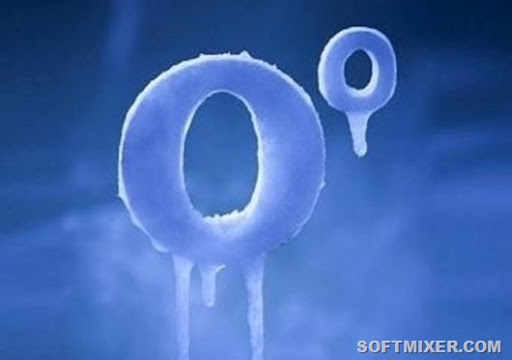The term "temperature" appeared at a time when physicists thought that warm bodies consist of more specific substance - caloric - than the same bodies, but cold. And the temperature was interpreted as a value corresponding to the amount of caloric in the body. Since then, the temperature of any body has been measured in degrees. But in fact, this is a measure of the kinetic energy of moving molecules, and, based on this, it should be measured in Joules, in accordance with the System of Units C.
The concept " absolute zero temperature ”comes from the second law of thermodynamics. According to it, the process of heat transfer from a cold body to a hot one is impossible. This concept was introduced by the English physicist W. Thomson. For his achievements in physics, he was awarded the title of nobility "lord" and the title of "Baron Kelvin". In 1848 W. Thomson (Kelvin) proposed to use a temperature scale, in which the starting point was taken to be the absolute zero temperature corresponding to the extreme cold, and the degree of Celsius was taken as the division value. The Kelvin unit is 1/27316 the fraction of the temperature of the triple point of water (about 0 degrees C), i.e. temperature at which pure water is immediately in three forms: ice, liquid water and steam. temperature is the lowest possible low temperature, at which the movement of molecules stops, and it is no longer possible to extract thermal energy from the substance. Since then, the scale of absolute temperatures has been named after him.
Temperature is measured on different scales
 The most commonly used temperature scale is called the Celsius scale. It is built at two points: at the temperature of the phase transition of water from liquid to steam and water to ice. A. Celsius in 1742 proposed to divide the distance between the reference points into 100 intervals, and take the water as zero, while the freezing point is 100 degrees. But the Swede K. Linnaeus suggested doing the opposite. Since then, the water has been freezing at zero degrees A. Celsius. Although it should boil exactly in Celsius. Absolute zero in Celsius corresponds to minus 273.16
The most commonly used temperature scale is called the Celsius scale. It is built at two points: at the temperature of the phase transition of water from liquid to steam and water to ice. A. Celsius in 1742 proposed to divide the distance between the reference points into 100 intervals, and take the water as zero, while the freezing point is 100 degrees. But the Swede K. Linnaeus suggested doing the opposite. Since then, the water has been freezing at zero degrees A. Celsius. Although it should boil exactly in Celsius. Absolute zero in Celsius corresponds to minus 273.16
There are a few more temperature scales: Fahrenheit, Reaumur, Rankin, Newton, Roemer. They have different pivot points and divisions. For example, the Reaumur scale is also built on the boiling and freezing points of water, but it has 80 divisions. The Fahrenheit scale, which appeared in 1724, is used in everyday life only in some countries of the world, including the USA; one is the temperature of the mixture of water ice - ammonia and the other is the temperature of the human body. The scale is divided into one hundred divisions. Zero Celsius corresponds to 32 Converting degrees to Fahrenheit can be done using the formula: F = 1.8 C + 32. Reverse translation: C = (F - 32) / 1.8, where: F - degrees Fahrenheit, C - degrees Celsius. If you are too lazy to count, go to the online service for converting Celsius to Fahrenheit. In the box, type the number of degrees Celsius, click "Calculate", select "Fahrenheit" and click "Start". The result will appear immediately.
 The Rankin scale is named after the English (more precisely Scottish) physicist William J. Rankin, a contemporary of Kelvin and one of the founders of technical thermodynamics. There are three important points on its scale: the beginning is absolute zero, the freezing point of water is 491.67 degrees of Rankin and the boiling point of water is 671.67 degrees. The number of divisions between the freezing of water and its boiling in both Rankin and Fahrenheit is 180.
The Rankin scale is named after the English (more precisely Scottish) physicist William J. Rankin, a contemporary of Kelvin and one of the founders of technical thermodynamics. There are three important points on its scale: the beginning is absolute zero, the freezing point of water is 491.67 degrees of Rankin and the boiling point of water is 671.67 degrees. The number of divisions between the freezing of water and its boiling in both Rankin and Fahrenheit is 180.
Most of these scales are used exclusively by physicists. And 40% of the American high school students surveyed these days said that they did not know what absolute zero temperature is.
What is absolute zero (usually zero)? Does this temperature really exist anywhere in the universe? Can we chill something to absolute zero in real life? If you're wondering if you can outrun the cold wave, let's explore the farthest limits of cold temperature ...
Even if you are not a physicist, you are probably familiar with the concept of temperature. Temperature is a measure of the amount of internal random energy in a material. The word "inner" is very important. Throw a snowball, and although the main movement will be fast enough, the snowball will remain quite cold. On the other hand, if you look at air molecules flying around a room, an ordinary oxygen molecule is roasting at a speed of thousands of kilometers per hour.
We tend to fall silent when it comes to technical details, so for the experts we point out that temperature is a little more complex than we said. A true definition of temperature means how much energy you need to expend for each unit of entropy (mess, if you want a clearer word). But let's skip the subtleties and just stop at the fact that random air or water molecules in the ice will move or vibrate more and more slowly as the temperature decreases.
Absolute zero is a temperature of -273.15 degrees Celsius, -459.67 Fahrenheit and just 0 Kelvin. This is the point where the thermal movement stops completely.

Does everything stop?
In the classical consideration of the question, everything stops at absolute zero, but it is at this moment that the terrible muzzle of quantum mechanics peeps out from around the corner. One of the predictions of quantum mechanics that has spoiled the blood of a fair number of physicists is that you can never measure the exact position or momentum of a particle with perfect certainty. This is known as the Heisenberg uncertainty principle.
If you could cool an airtight room to absolute zero, strange things would happen (more on that in a moment). The air pressure would drop to near zero, and since air pressure usually opposes gravity, the air collapses into a very thin layer on the floor.
But even so, if you can measure individual molecules, you will find something curious: they vibrate and rotate, very little - quantum uncertainty at work. To dot the i: If you measure the rotation of carbon dioxide molecules at absolute zero, you will find that oxygen atoms are flying around carbon at a speed of several kilometers per hour - much faster than you expected.
The conversation comes to a standstill. When we talk about the quantum world, movement loses its meaning. At this scale, everything is determined by uncertainty, so it's not that the particles are stationary, you just can never measure them as if they were stationary.
How low can you fall?
Striving for absolute zero essentially meets the same problems as striving for the speed of light. It takes an infinite amount of energy to gain the speed of light, and reaching absolute zero requires extracting an infinite amount of heat. Both of these processes are impossible, if anything.
Despite the fact that we have not yet achieved the actual state of absolute zero, we are very close to this (although "very" in this case, the concept is very extensible; like a children's counting room: two, three, four, four and a half, four on a string, four by a thread, five). The lowest temperature ever recorded on Earth was recorded in Antarctica in 1983, at around -89.15 degrees Celsius (184K).

Of course, if you want to cool off not childishly, you need to dive into the depths of space. The entire universe is flooded with the remnants of radiation from the Big Bang, in the empty regions of space - 2.73 degrees Kelvin, which is slightly colder than the temperature of liquid helium, which we were able to get on Earth a century ago.
But low-temperature physicists are using freezing beams to bring technology to a completely new level... It may surprise you that the freezing beams take the form of lasers. But how? Lasers have to burn.
That's right, but lasers have one feature - one might even say an ultimatum: all light is emitted at the same frequency. Ordinary neutral atoms do not interact with light at all unless the frequency is precisely tuned. If the atom flies towards the light source, the light gets a Doppler shift and goes to a higher frequency. The atom absorbs less photon energy than it could. So if you tune the laser down, fast-moving atoms will absorb light, and when emitting a photon in a random direction, they will lose a little energy on average. By repeating the process, you can cool the gas to less than one nanoKelvin, a billionth of a degree.
Everything takes on a more extreme color. The world record for the lowest temperature is less than one tenth of a billion degrees above absolute zero. Devices that do this trap atoms in magnetic fields. "Temperature" depends not so much on the atoms themselves as on the spin of atomic nuclei.
Now, to restore justice, we need to fantasize a little. When we usually imagine something frozen to one billionth of a degree, you are probably drawing a picture of how even air molecules freeze in place. One can even imagine a devastating apocalyptic device freezing the spins of atoms.
Ultimately, if you really want to experience low temperatures, all you have to do is wait. After about 17 billion years, the background radiation in the Universe will cool down to 1K. In 95 billion years, the temperature will be about 0.01K. In 400 billion years, deep space will be as cold as the coldest experiment on Earth, and even colder after that.

If you're wondering why the universe is cooling down so quickly, thank our old friends: entropy and dark energy. The universe is in acceleration mode, entering a period of exponential growth that will continue forever. Things will freeze very quickly.
What do we care?
All this, of course, is wonderful, and breaking records is also nice. But what's the point? Well, there are plenty of good reasons to be smart about low-temperature temperatures, and not just as a winner.
The nice guys at the National Institute of Standards and Technology, for example, just wanted to make a cool watch. Time standards are based on things like the frequency of the cesium atom. If the cesium atom moves too much, it creates measurement uncertainty, which ultimately causes the clock to malfunction.
But more importantly, especially from a scientific point of view, materials behave insanely at extremely low temperatures. For example, just as a laser is made of photons that synchronize with each other - at the same frequency and phase - so a material known as a Bose-Einstein condensate can be created. In it, all atoms are in the same state. Or imagine an amalgam in which each atom loses its individuality and the entire mass reacts as one null-super-atom.
At very low temperatures, many materials become superfluid, which means they can be completely non-viscous, stacked in ultra-thin layers, and even defy gravity to achieve minimum energy. Also at low temperatures, many materials become superconducting, which means there is no electrical resistance.
![]()
Superconductors are capable of reacting to external magnetic fields in such a way as to completely cancel them inside the metal. As a result, you can combine the cold temperature and the magnet and get something like levitation.
Why is there an absolute zero but no absolute maximum?
Let's take a look at the other extreme. If temperature is just a measure of energy, then one can simply imagine atoms getting closer and closer to the speed of light. Can't it go on forever?
There is a short answer: we don't know. It's possible that there is literally such a thing as infinite temperature, but if there is an absolute limit, the young universe provides some pretty interesting clues as to what it is. The highest temperature that has ever existed (at least in our universe) probably happened during the so-called "Planck time".
It was a moment 10 ^ -43 seconds long after the Big Bang, when gravity separated from quantum mechanics and physics was exactly what it is today. The temperature at the time was about 10 ^ 32 K. This is a septillion times hotter than the interior of our Sun.
Again, we're not at all sure if this is the hottest temperature it could possibly be. Since we do not even have a large model of the universe at Planck's time, we are not even sure that the universe boiled to such a state. In any case, we are many times closer to absolute zero than to absolute heat.
The science
Until recently, the coldest temperature that a physical body could have was considered to be the temperature of "absolute zero" on the Kelvin scale. It corresponds −273.15 degrees Celsius or −460 degrees Fahrenheit.
Now physicists from Germany have been able to reach temperatures below absolute zero. Such a discovery will help scientists understand phenomena such as dark energy and create new forms of matter.
Absolute zero temperature
In the mid-19th century, the British physicist Lord Kelvin created the scale absolute temperature and determined that nothing could be colder than absolute zero... When particles are at absolute zero, they stop moving and have no energy.
An object's temperature is a measure of how much atoms are moving. The colder the object, the slower the atoms move. At absolute zero or -273.15 degrees Celsius, atoms stop moving.

In the 1950s, physicists began to argue that particles do not always lose energy at absolute zero.
Scientists from Ludwig-Maximilian University in Munich and Max Planck Institute for Quantum Optics gas was created in Garching, which became colder than absolute zero by a few nanokelvin.
They cooled about 100,000 atoms to positive temperature several nanokelvin (nanokelvin is one billionth of a kelvin) and used a network of laser beams and magnetic fields to control the behavior of atoms and push them to a new temperature limit.
Highest temperature

If the lowest possible temperature is considered absolute zero, then what temperature can be considered its opposite - the highest temperature? According to cosmological models, the highest possible temperature is the Planck temperature, which corresponds to 1.416785 (71) x 1032 kelvin (141 nonillion 679 octillion degrees).
Our Universe has already passed through the Planck temperature. This happened 10 ^ -42 seconds after the Big Bang, when the universe was born.
The coldest temperature on Earth

The lowest temperature on Earth was recorded on July 21, 1983 at Vostok station in Antarctica, and it was -89.2 degrees Celsius.
Vostok Station is the coldest permanent inhabited place on Earth. It was founded by Russia in 1957 and is located 3488 meters above sea level.
The highest temperature on Earth

The highest temperature on Earth was recorded on July 10, 1913 in Death Valley in California and it was 56.7 degrees Celsius.
Previous record of the most high temperature the world in the city of Al-Aziziya in Libya, which amounted to 57.7 degrees Celsius, was refuted World Meteorological Organization due to unreliable data.
The site is under restoration. Text editing is temporarily unavailableAbsolute zero (another version of the spelling "absolute zero")- the maximum minimum temperature. Corresponds to approximately - 273.15 degrees Celsius or 0 degrees Kelvin.
The concept of absolute zero came about after it was suggested that the observed heat is the speed at which particles move. Theoretically, it has been proposed that absolute zero is when even the smallest particles - atoms - stop moving.
In fact, this temperature is unattainable, since atoms retain a small amount of energy and only their complete absence corresponds to absolute zero.
At temperatures close to absolute zero, quantum phenomena are more clearly manifested, which made it possible to create simple, quantum computers using the cooling method.
With a decrease in the temperature of metals, they have the properties of superconductivity.
Scientists managed to cool atoms to temperatures close to absolute zero - up to 170 nanokelvin (less than one degree Kelvin, approximately - 273.14 Celsius).
The history of obtaining super-cold objects
First experiences
The first attempts to obtain "super-cold objects" were little more than freezing water with the addition of salt. The added salt, depending on the concentration, raised the freezing point of the water by several degrees above 100 degrees Celsius. (For a long time, the Celsius scale was "inverted)A similar phenomenon in the waters of the Northern and Antarctic oceans
Discovery of liquefaction of gases
A significant advance in lowering the temperature became the chlorine gas experiment. As a result of the experiment, the scientist became interested in the unexpectedly appeared greenish liquid at the bottom of a sealed flask with heated gas. Having broken the flask (while injuring his eyes with shrapnel), he saw that the liquid had evaporated, and frost had appeared in the place where it had been. So the liquefaction of gases was first discovered - with increasing pressure, as well as cooling objects - with the evaporation of the resulting liquid.The scientist described and suggested that this phenomenon can be used in the future for storing food.
In the future, Faraday received liquefied all gases known at that time, except: carbon monoxide, oxygen and hydrogen.
The remaining gases, under the influence of only pressure, became more and more difficult to turn into a liquid state, and hydrogen could not be obtained at all.
Production of liquid hydrogen -222.65 ° C and helium - 268.9 ° C
The next who managed to significantly approach the temperature of absolute zero was James Dewar, who managed to cool hydrogen to a temperature of -222.65 ° C. For cooling, in addition to the pressure used, he used chain cooling of gases, liquid oxygen - cooled hydrogen.Soon, in the neighboring laboratory where James worked, the discovery of helium, which in the liquid state should have had a temperature of 268.9 ° C, took place. James Dewar began trying to liquid helium, but faced many problems. The scientist who discovered helium was in a quarrel in it, and the balloon with expensive (at that time) helium, acquired in the end, was accidentally deflated by his assistant.
Heike Kamerlingh Onnes, using the same cascade cooling technology, beat James and won the Nobel Prize for liquid helium.
Helium, at temperatures close to absolute zero, turned out to have unusual properties. These properties are called superfluidity and zero viscosity. Liquid helium was able to overcome the capacity of the vessel in which it was located and rose up the walls. In 1939, the Russian scientist Pyotr Leonidovich Kapitsa first discovered superfluidity. A tiny, endlessly flowing "fountain" appeared inside the liquid helium droplet with a further increase in pressure.
Liquid helium is still considered the coldest substance ever produced by man, apart from Einstein's Bohr condensate. Helium is not able to go into a solid state even at absolute zero (without increasing pressure).
Bohr-Einstein condensate production: 170 nanokelvin
In the 20s of the XX century, the Indian scientist Shatyendranata Bose sent a letter with his work on calculating phenomena according to the theories of Einstein. Einstein, in collaboration with Bose, predicted the appearance of a special aggregate substance at a temperature still close to absolute zero. This state of aggregation was named after the name of the scientists "Bohr-Einstein condensate". Condensate has quantum properties at the macroscopic level.
The Bohr-Einstein condensate was obtained only in 1995. In order to bring the temperature as close as possible to absolute zero, lasers were used, which slowed down the movement of particles and a "capacitor" released rapidly moving particles.
The condensate temperature is 170 nanokelvin. Inside, the movement of light slows down.




